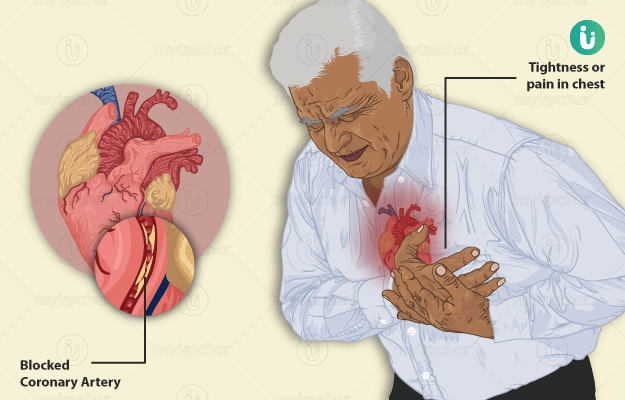What is Angina?
Angina is a discomfort in the chest experienced due to a reduced supply of oxygen-rich blood to the heart muscles. It is not a disease but a symptom of an underlying heart disease, such as coronary artery disease, wherein the supply of oxygenated blood to the heart decreases due to narrowing of the arteries. Plaques develop in the arteries that supply blood to the heart, eventually causing reduced blood flow and oxygen supply to the heart muscles.
Please click on this link to know better about heart disease treatment.
(Read More - Broken Heart Syndrome)
What are the main signs and symptoms of angina?
There are three types of angina: stable, unstable, and variant angina. The symptoms are generally seen according to the type of angina. Chest pain is the major symptoms experienced. Tightness or squeezing sensation in the chest; pain spreading to the arm, neck, jaw, shoulder, or back; nausea; fatigue; shortness of breath; sweating; and dizziness are other symptoms. The pain felt can be similar to acidity or indigestion.
(Read More - Heart attack in young adults)
What are its main causes?
Angina is a symptom indicative of an underlying heart problem. Fatty deposits called plaques accumulate in the arteries, thereby narrowing the artery. This causes a reduction in oxygen-rich blood flow to the heart (ischaemia). The supply is generally managed during rest, but when a person exercises, walks or climbs the stairs, there is a greater need of oxygen-rich blood supply to the heart muscles, which cannot be sufficed. Hence, it causes chest pain that progresses to the arms, neck, shoulder, back and other body parts. This pattern is seen in stable angina.
In unstable angina, the plaque sometimes detaches from the wall of an artery and flows along with the blood, which may cause a block or partial block in the artery, leading to sudden chest pain and other symptoms. The chest pain occurs even at rest and exaggerates on physical exertion.
Also, due to emotional stress, smoking, cold weather, heavy meal, or physical activity, the coronary artery is narrowed and hence causes angina symptoms; this type is called variant angina.
(Read More - Atrial Fibrillation treatment)
How is it diagnosed and treated?
Following a chest pain, your doctor may ask you about your symptoms, what type of activity you were doing when the pain started, and information regarding family’s medical history, dietary habits, smoking habits, lifestyle, exercise pattern, body weight, height, waist, body mass index, among others. Thereafter, he/she may perform tests, such as electrocardiogram (ECG), blood pressure, blood test, blood lipids, chest X-ray, coronary angiography, computerised tomography scan, and ECG stress test. Unstable angina requires immediate diagnosis and emergency treatment to prevent a heart attack.
The successful treatment of angina needs complete trust in your doctor and clearly sharing with him/her all the problems that you face. After confirmation of the diagnosis, doctors will initially start a medication depending upon the type of angina. Initial changes along with medication that may be needed include lifestyle modification, good dietary habits, and some other interventions, such as a heart surgery.
At initial angina attack, doctors will immediately prescribe glyceryl trinitrate (GTN) to avoid another attack. GTN is available as a sublingual tablet or spray. After an angina attack, stop working immediately, take rest, take GTN, and repeat the dose after five minutes if the first dose does not work. Medicines, such as GTN, beta blockers, and calcium channel blockers can also be used to prevent an attack. Angina is a warning sign that you are at a higher risk of having a heart attack; hence, other medications to prevent a heart attack are also needed, which include low-dose aspirin, statins, and angiotensin-converting enzyme inhibitors.
Surgical intervention can also be employed if medicines alone do not control the condition. This includes rerouting the blood flow by using grafts, such as a section of the vessel from another part of the body (coronary artery bypass graft surgery) or artery-widening using stents (percutaneous coronary interventions). For unstable angina, medicines for preventing the formation of blood clots and lowering the risk of a heart attack are prescribed. You will be immediately given low-dose aspirin, clopidogrel, and injection of a blood-thinning medicine. Surgery will be performed if there is a high risk of worsening of the condition or developing another associated ailment.
(Read More - How long does a heart attack last without treatment)
(Get online doctor consultation for any health issue)

 OTC Medicines for Angina
OTC Medicines for Angina















